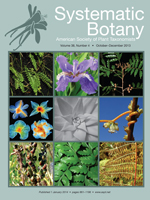The diversity of Mertensia (Boraginaceae), a monophyletic group that is widely distributed in Asia, Beringia, North America, and circumboreal locales, has presented considerable taxonomic difficulties. Phylogeny reconstructions based on DNA sequence data from eleven chloroplast (cp) regions were used to infer evolutionary lineages, address problematic taxonomic circumscriptions, test hypotheses of relationships, and discuss variation of morphological characters in Mertensia (Boraginaceae). Phylogenetic analyses using maximum parsimony, maximum likelihood, and Bayesian inference consistently recovered three clades that largely correspond to geography. One clade consisted of a grade of Asian taxa, a Beringian subclade, and a circumboreal subclade. A second clade consisted of the Beringian M. rivularis and was weakly to moderately supported as sister to a third clade, which consisted only of North American taxa. Although we recovered weak support for many of the deeper nodes in the North American clade, our results provided moderate to strong support for 13 subclades. Hypothesis testing using the Shimodaira-Hasegawa (SH) and Approximately Unbiased (AU) tests rejected several earlier hypotheses of relationships except for three models of relationships suggested by Williams: (1) section Mertensia sensu Williams; (2) M. oreophila and M. oblongifolia var. nevadensis sensu Williams; and (3) M. arizonica var. arizonica, M. arizonica var. subnuda, M. grahamii, and M. toyabensis sensu Williams. In the latter three cases, alternative phylogenetic hypotheses were rejected by the AU test but not by the SH test. The North American clade includes M. ciliata, M. lanceolata, M. oblongifolia, and M. viridis, for which broad circumscriptions by some authors have been especially problematic. Our phylogenetic results recovered these taxa as polyphyletic and hypothesis tests rejected the monophyly of each of these species when treated broadly. We recommend narrow circumscriptions for each of these taxa and suggest further studies of the oblongifolia complex. Our results represent the first and most comprehensive molecular phylogeny to date for Mertensia. We propose to emend the section Stenhammaria to include Asian, Beringian, and circumboreal taxa. New combinations include: Mertensia grahamii, Mertensia longipedunculata, Mertensia ovata var. caelestina, and Mertensia parvifolia.
How to translate text using browser tools
1 May 2014
Phylogenetic Systematics of the Genus Mertensia (Boraginaceae)
Mare Nazaire,
Larry Hufford
ACCESS THE FULL ARTICLE

Systematic Botany
Vol. 39 • No. 1
February 2014
Vol. 39 • No. 1
February 2014
ancestral state reconstruction
hypothesis testing
maximum likelihood
Molecular phylogenetics




